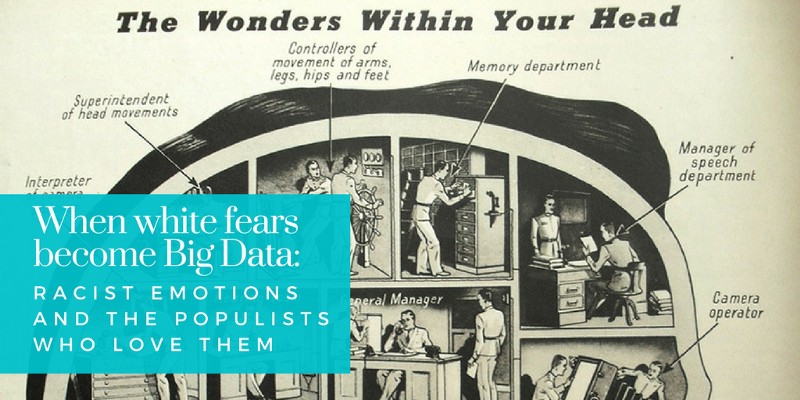When white fears become Big Data: racist emotions and the populists who love them
When white fears become Big Data: racist emotions and the populists who love them

At the end of last year I started exploring issues surrounding Big Data from a political standpoint. The first essay summarized the history of Big Data in terms of interventions over marginalized groups. In the second essay of the series, I touched on libertarian conceptions of privacy and how it is demarcated within blurred boundaries that often contradict each other (i.e by deeming the internet a private space while the streets are conceived as public). In the third part of this series, I wrote about how “communal data” (that is, data pertaining demographic information about communities) is often used to further marginalize groups that have no protections against this use of data.
For the past year, with election cycles in the US and most of Western Europe, a specific set of data points is being collected with the purpose of setting up platforms and policies: white voters’ emotions. Fear, disgust, hatred, rejection, aversion, antipathy: all of these and more are being exhaustively measured to determine platforms and talking points for candidates. Jonathan Albright wrote an extensive analysis of the use of white voters emotions processed as Big Data in order to shape Donald Trump’s election campaign. White emotions have become such a powerful political tool that we are even admonished for not prioritizing them when evaluating a politician’s record. In all of these cases, the targets of the negative emotions are already marginalized groups such as people of color, Muslims, immigrants, LGBTQ, disabled people, the poor. Across the Western World, numbers resulting from surveying these same emotions are being used to oversee and legislate these groups through extended police interventions, elevated terror threats or increased security measures.
However, whenever these marginalized groups express their own emotional concerns, they are usually dismissed as a “statistical anomaly” and not a valid data point to be considered for policy or platform making. This data collection, to be considered valid, must always originate from the dominant culture. As mentioned in a previous essay from this series, demographic data such as poverty levels in a community combined with surveys pertaining to white fears of people of color can result in strict and often violent policing under the claim that these communities present “structural problems”. However, if people of color express fear of being unjustly killed in police interventions or of being discriminated in the job market, their emotions are not coded as part of a structural problem. Instead, they are considered the realm of individual perception and dismissed as such.
That white fears can result in harmful or even deadly situations for marginalized groups is perhaps best illustrated in the practice of “racial profiling”. Members of specific groups such as Black, Latino, Middle Eastern, South Asian or North African people are perceived as “prone to commit crimes” or “potential terrorists” and targeted for police actions that can have deadly results. Racial profiling was first instituted in the US during slavery when, in 1693, American court officials gave police legal authority “to stop and detain any Negro (freed or enslaved) seen wandering in and around on the streets”. Eventually, a practice that was started in European colonies in the Americas, would return, repurposed and actualized, to the continent as well. Proponents of racial profiling often cite crime statistics or terrorist acts supposedly committed by people of color to justify the practice. The figures, they claim, are “objective”.
It has also become common to label all fears or concerns from marginalized groups as “weaknesses”. Words like “special snowflake” are used against anyone who expresses a need based on fears for their safety or well being. Safe spaces (that is, spaces that offer some form of protection for marginalized individuals) are mocked and deemed a sign of excessive worry for the needs of people who should just “toughen up”. However, the same emotional data when it originates from white people in positions of political power is regularly used to inform legislation, safety measures and to create policy. While emotional data originated from marginalized subjects is treated as an anomaly, the same aggregated data from the dominant culture becomes “the neutral” under which everyone else is forced to comply.
It is in this combined use of supposedly “neutral” aggregated data and recorded white emotions that the assumed “objective” statistic becomes a tool of State intervention over marginalized groups. Statistics of poverty or unemployment among people of color are used to “prove” that these groups do not work hard enough thus confirming white fears. In turn, these statistics are removed from the overall socio-historical context that created structural problems to begin with. Politically tendentious uses of records regarding the use of food assistance programs by single parents can give way to the myth of the “welfare queen”, again, confirming the deep seated emotion held against single mothers, especially when those mothers are of color. In turn, media exacerbates these emotions by presenting these cases as undeniable truths. Again, statistics are used to “prove” a stereotype created by white dominant emotions. However, if a member of these stigmatized groups reacts with an emotion of their own, this is not incorporated as a “valid data point” over which policies or social programs can be enacted. While the prevailing belief surrounding Big Data is that these data sets are “neutral” in the sense that they just aggregate specific, algorithmically predetermined fields, there is nothing neutral, unbiased, unprejudiced or objective in the emotional quality of the material in question. Big Data is shaped by the emotional state of the dominant culture while the emotional woes of the marginalized remain a statistical anomaly or merely Subaltern Data to be dismissed or mocked by those with institutional power.
In the next post of this series, we will expand on the ethics of surveying and surveilling communities and the current protections afforded to the data collected in these processes.

I am an independent writer with no affiliations. If you find value in the type of work I do, please consider making a donation. Any funds, no matter how small will allow me to continue this ongoing research and analysis. Follow me on Twitter for daily updates.
For the past decade and a half I have been making all my content available for free (and never behind a paywall) as an ongoing practice of ephemeral publishing. This site is no exception. If you wish to help offset my labor costs, you can donate on Paypal or you can subscribe to Patreon where I will not be putting my posts behind a lock but you'd be helping me continue making this work available for everyone. Thank you. Follow me on Twitter for new post updates.

